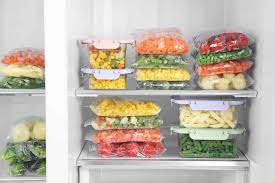If you’re thinking about filling your pantry with nutritious foods that also stand the test of time, you’re not alone. Especially during uncertain times or emergencies, knowing what to keep and what to avoid can help support both your health and your peace of mind.
Many foods can last a long time — but not all of them are good for you. Choosing the right ones means focusing on nutrition, not just shelf life.
“It can be easy to reach for sugary comfort snacks when life is stressful,” said Erin Palinski-Wade, RD, author of Belly Fat Diet for Dummies. “But those choices won’t give your immune system or energy levels the support they need.”
Instead, she recommends stocking up on foods rich in antioxidants, protein, healthy fats, and fiber. Below are 9 better-for-you, long-lasting options — and 6 less healthy picks you might want to leave behind.
✅ Better Long-Term Food Picks
1. Prunes
Naturally sweet and shelf-stable for up to a year, prunes are a great fruit option when fresh produce isn’t available.
“They’re fiber-rich and very versatile,” Palinski-Wade said. “Snack on them, blend into baked goods, or add to homemade trail mix.”
They also help support bone health — eating 5–6 prunes a day may help prevent bone loss.
2. Pulses (Lentils, Chickpeas, Beans, and Dry Peas)
Packed with plant-based protein (about 8 grams per half-cup), pulses are nutritious and budget-friendly.
“Whether canned or dried, they can last for up to a year and are great in soups, stews, salads, or even baked items,” said Palinski-Wade.
Check out recipes and cooking tips at pulses.org.
3. Winter Squash & Cabbage
Thanks to their thick skin, winter squashes like butternut and spaghetti squash can last for months at room temperature.
Cabbage, stored in the fridge, stays fresh for about a month and is a hearty, vitamin-packed veggie that works in slaws, stir-fries, or braised dishes.
4. Frozen Spiralized Veggie “Pasta”
Rather than stocking up on regular white pasta or rice, go for frozen spiralized or riced vegetables like zucchini noodles or cauliflower rice.
“They last longer than fresh vegetables and help stabilize blood sugar,” Palinski-Wade noted.
Brands like Green Giant offer a variety of frozen veggie options nationwide.
5. Oats
Rolled or steel-cut oats are pantry staples with a shelf life of 1–2 years unopened. They’re versatile and full of fiber.
“Use them for breakfast, add to baked goods, or make oat milk,” said cook and author Amanda Frederickson.
6. Canned Tuna and Salmon
A top pick for protein and omega-3s, canned fish can be stored for long periods and used in salads, sandwiches, or casseroles.
Buying lean meats and freezing them is another way to keep proteins stocked.
7. Canned Coconut Milk
Frederickson says she always keeps this on hand for curries, oatmeal, or dairy-free desserts. It stores well for a year or more.
8. Pyure Organic Stevia Blend
If you’re doing a lot of baking, consider using a zero-calorie sweetener like Pyure stevia blend instead of sugar.
“It has no carbs, no calories, and a 2-year shelf life,” said Palinski-Wade. “Use it in drinks, baking, or anywhere you’d add sugar.”
9. Veggies Made Great Chocolate Muffins
Need a sweet treat? These muffins offer rich chocolate flavor with a hidden veggie boost — the first two ingredients are zucchini and carrots.
“They taste indulgent but offer antioxidant benefits too,” Palinski-Wade said.
❌ Long-Lasting Foods to Limit or Avoid
1. Instant Pancake Mix
These convenient mixes are often made with refined flour and offer little nutrition.
“Instead, try a protein-rich, whole-grain option like Kodiak Cakes,” Palinski-Wade advised.
2. Toaster Strudels
High in sugar and refined carbs, these frozen breakfast pastries can spike energy levels — then leave you crashing later.
They’re fine as a rare treat, but not as a regular breakfast staple.
3. Frozen Fried Chicken
Yes, it lasts a long time — but breaded and fried chicken options are high in calories and saturated fat.
Look for baked versions or unbreaded cooked chicken instead.
“The type of fat matters more than how much you eat,” said Kris Sollid, RD, from the International Food Information Council Foundation. “Choose more unsaturated fats over saturated ones.”
4. Frozen Pizza (Stuffed Crust or Meaty Varieties)
Some frozen pizzas are overloaded with sodium and saturated fat. For example, one slice of a stuffed-crust, meat-loaded pizza can contain half your daily recommended saturated fat.
Opt for thin crust veggie pizzas instead, like DiGiorno’s Thin & Crispy Garden Vegetable, which contains fewer calories and less fat per serving.
5. Cream-Based Canned Soups
Creamy soups often pack on the calories, sodium, and unhealthy fats.
Choose broth-based, low-sodium versions with vegetables and lean proteins — such as minestrone.
Sollid noted that low-sodium items contain 140 mg of sodium or less per serving.
6. Ice Cream (Bulk Sizes)
Giant tubs of ice cream can lead to overeating. Instead, consider portion-controlled treats like single-serve bars — or make your own banana-based “nice cream” from frozen fruit.
“Added sugars aren’t necessary for your diet, and should make up less than 10% of your daily calories,” Sollid said.
Bottom Line
When stocking up, it’s easy to reach for foods that offer comfort — but making smart choices will better support your energy, immunity, and long-term health. By focusing on nutrient-dense, shelf-stable foods and limiting ultra-processed options, you can be prepared without compromising your well-being.

